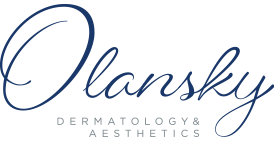Though raging teen hormones often come paired with raging teen skin problems, acne isn’t only for the pubescent-at-heart. In fact, the American Academy of Dermatology Association reports that it is the most common skin condition in the United States, impacting as many as 50 million Americans each year.
Inflammation, pore blockage, overactive oil glands, and the activity of normal skin bacteria are the four major contributors to acne flareups. Your COVID-19 mask-wearing protection may have contributed to a breakout or two of “maskne,” as well.
Fortunately, there are several effective approaches to acne treatment, regardless of your age, and our professionals at Olansky Dermatology & Aesthetics are eager to identify the cause and provide the most beneficial, customized treatment solution.
Cleansing & Moisturizing
Keeping your skin clean is one of the best ways to combat acne. Using a gentle cleanser twice daily will help clear away dirt, bacteria, and dead skin cells lingering on the surface and in your pores. But be careful — a harsh cleanser may irritate your skin and strip away essential moisture.
Speaking of moisture, applying a moisturizer regularly may seem illogical when you have oily skin, but “oily skin can still dry out if you use harsh facial cleansers, which can damage the skin’s natural barrier,” London-based consultant dermatologist Thivi Maruthappu cautioned PopSugar. “This can trigger over-production of oil, meaning your oily skin can end up worse off than you started.”
Finding the right skin care combination may take trial and error — or the care and attention of a dermatologist, who can help identify the right cleansing cure.
Resist the Temptation to Pick or Pop
Pimple-popping videos may have become a sickening-but-satisfying trend, but picking at or attempting to pop a pimple can lead to scarring or further infection. Dirt or bacteria from your fingers may also make things worse.
Though you can find advice around safely draining a whitehead or blackhead, we recommend leaving inflamed acne absolutely alone. This form of acne develops more deeply in the skin, and will be best treated by a dermatologist.
OTC and Prescription Treatments
To help clear things up beyond cleansing, here are a few ingredients that may be found in over-the-counter or prescription acne medications and how the American Academy of Dermatology Association indicates they can help:
- Benzoyl peroxide decreases bacteria
- Retinoids unclog pores and reduce oiliness
- Salicylic acid eases inflammation and unclogs pores
Be sure to allow 4-6 weeks for any acne treatment to work.
Other Advanced Options
For acne that may be resistant to other forms of treatment, there are further options.
Laser Treatment
More commonly used to treat acne scarring, certain laser treatments can help zap zits, as well.
Joshua Zeichner, MD, director of cosmetic and clinical research in dermatology at Mount Sinai Hospital in New York City recommends a type that uses intense pulsed light which kills bacteria and can reduce pimple inflammation.
Blue Light Photodynamic Therapy
This form of treatment combines both light and medicine to kill the excess bacteria that cause acne breakouts. Side effects of photodynamic therapy can include dryness, redness, pain and swelling, and sun sensitivity. But “Studies show blue light therapy clears up acne by nearly 70% within 8 to 10 treatment sessions,” according to the experts at WebMD.To avoid frustration and speed a cure, we encourage you to speak to a dermatologist sooner rather than later when it comes to your acne — no matter how old you are. To book an appointment and start finding solutions, connect with us online or call (404) 355-5484.


